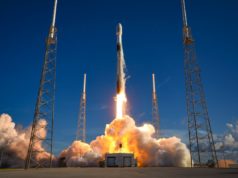
Two B330s are shown in low-Earth orbit, with a Boeing CST-100 and SpaceX Dragon spacecraft docked. (credit: Bigelow Aerospace)
Throughout our planet’s space-faring history, there have been two major impediments to putting a lot of private citizens into orbit. Only governments have had spacecraft, and there have been only a few government-controlled space stations to visit. But now that may finally changing in a big way. Within less than two years, both Boeing and SpaceX should complete development of private capsules that will carry people into space. Two other companies, Blue Origin and Sierra Nevada, are also developing orbital spacecraft.
The second part of the problem may soon be addressed as well. Less than a week after the launch of Bigelow Aerospace’s experimental 13-foot habitat to the International Space Station, the company has announced an agreement with United Launch Alliance to deliver two much larger B330 habitats into orbit by 2020. Each of these habitats, which will be fully self-sufficient, has 330 cubic meters of habitable volume—about one-third that of the space station.
Financial details of the agreement were not released, but the move is significant because of its potential to become the first truly commercial human activity in space—people launching aboard private spacecraft and staying in a privately developed habitat. “We are standing on the very threshold of an expanded and permanent human presence beyond our planet, and the foundation for that future will be the commercialization of low-Earth orbit,” said Tory Bruno, president and chief executive of United Launch Alliance, at a news conference this week.
Read 11 remaining paragraphs | Comments
![]()







